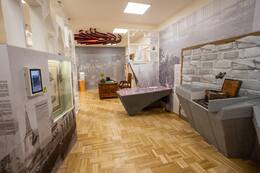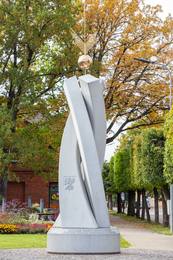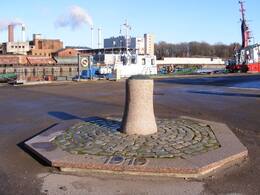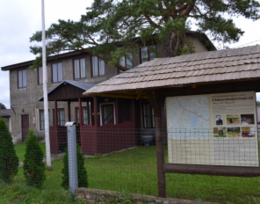Latvijos laikinoji nacionalinė taryba (LPNP)
I WW1, I Nepriklausomybės karai
Latvijos laikinoji tautinė taryba (LPNP) – Latvijos politinė atstovaujamoji organizacija, įkurta 1917 m. lapkritį Valkoje (angl. Latvian Provisional National Council, German Lettlands Vorläufiger Nationaler Rat, Russian Латышский временный национальный совет).
LPNP delegavo Latvijos politinės partijos ir visuomeninės organizacijos. Ši organizacija tarptautiniu mastu gynė latvių tautos apsisprendimo teises iki Latvijos liaudies tarybos posėdžio (1918 11 17). LPNP tikslas buvo pasisakyti už Latvijos tautą, susivienijusią į vientisą ir etnografinę teritoriją, atstovauti jos interesams kitoje taikos konferencijoje, užtikrinti Konstitucinės asamblėjos sušaukimą. Jos uždaviniai – sušaukti Latvijos Konstitucinę Asamblėją, kuri spręstų dėl Latvijos vidaus sistemos ir „užsienio santykių“; užtikrinti išsklaidytų žmonių grįžimą į tėvynę; protestuoti prieš bet kokį Latvijos prijungimą prie Vokietijos; reikalauti Latgalos atskyrimo nuo Vitebsko gubernijos ir prijungimo prie Latvijos.
1917 m. lapkričio 17 d. (vietos laiku) Valkoje LPNP įkūrė 29 delegatai iš 13 pilietinių partijų ir organizacijų. Įsteigus prasidėjo LPNP I sesija, trukusi iki 1917 m. gruodžio 19 d. Priimta keletas nutarimų ir deklaracijų, iš kurių svarbiausia – deklaracija „Užsienio šalims ir tautoms“: „Latvija, kuriai priklauso Vidžemė, Kuržemė ir Latgala, yra autonominis valstybės vienetas, kurio santykio su išoriniu pasauliu ryšis, besąmonės, yra. žmonių plebiscitas“.
19.11.(j.st.02.12).1917 m. išrinkta LPNP valdyba. Pirmininku išrinktas advokatas Voldemaras Zamuelis, bendrapirmininkais – advokatas Kārlis Pauļuks, antrasis leitenantas Jānis Rubulis ir karys Jānis Palcmanis; sekretoriumi – notaras Kristaps Bahmanis, sekretoriais – rašytojai Kārlis Skalbis ir Jānis Akuraters; kaip iždininkas – kooperatorius Vili Siliņš, kaip iždininko padėjėjas – komercijos inžinierius Eduards Laursons.
25.11 (j.st. 08.12.) 1917. LPNP išleido šūkį „Visiems latviams!“, kuris buvo išplatintas 30 tūkst. egzempliorių ne vokiečių okupuotoje Latvijos dalyje ir Latvijos pabėgėlių centruose Rusijoje. LPNP kreipimesi informavo apie savo įkūrimą ir paragino latvius pasinaudoti savo apsisprendimo teise. 1917 12 19. (JST 1918 01 01) Bolševikai uždraudė LPNP veiklą ir jos valdyba toliau veikė nelegaliai. Organizacijos Užsienio reikalų skyrius veikė Petrograde, kur 28-30 d. 1918-01-01. Susirinko 2-oji LPNP sesija, kuri savo priimtoje deklaracijoje pirmą kartą iškėlė tikslą, kad „Latvija būtų nepriklausoma demokratinė respublika, vienijanti Kuržemę, Vidžemę ir Latgalą“.
1918 metų spalį tarp LPNP ir Vokietijos okupuotoje Rygoje įkurto Demokratinio bloko prasidėjo diskusijos dėl Latvijos ikiparlamento įsteigimo. 1918 metų lapkričio 17 dieną įvyko paskutinis LPNP valdybos posėdis, kuriame buvo nuspręsta nedaryti kliūčių Latvijos liaudies tarybai, kuri lapkričio 18 dieną paskelbs Latvijos Respubliką, steigimui. Taigi LPNP nustojo egzistuoti.
Daugiau informacijos šaltinių
Janis Tomaševskis. Nepriklausomybės šnabždesiai: Latvijos laikinosios nacionalinės tarybos istorija, Ryga, Jumava, 2017; Janis Tomaševskis. Latvijos laikinoji nacionalinė taryba. Nacionalinė enciklopedija. https://enciklopedija.lv/skirklis/27579-Latvie%C5%A1u-pagaidu-nacion%C4%81l%C4%81-padome
Susijusi laiko juosta
Susijusios vietos
Ekspozicija „Valka – Latvijos Nepriklausomybės lopšys“
Valkos kraštotyros muziejus yra Valkoje, dešinėje Rygos gatvės pusėje, istoriniame Vidžemės parapijos mokyklos mokytojų seminarijos pastate. Nuo 1853 iki 1890 m. pastate veikė Vidžemės parapijos mokyklos mokytojų seminarija. Iki 1881 m. jai vadovavo Janis Cimze, mokytojas ir Latvijos chorinės kultūros pradininkas. Uždarius mokyklos mokytojų seminariją, pastatas 80 metų tenkino įvairius švietimo, kultūros ir buities poreikius. Nuo 1970 m. pastate įsikūręs Valkos kraštotyros muziejus. Nuolatinė muziejaus ekspozicija „Valka – Latvijos nepriklausomybės lopšys“ pasakoja apie socialinius ir politinius įvykius Valkoje nuo 1914 iki 1920 m., kai Latvija tapo nepriklausoma valstybe. Ekspozicija atspindi pasirengimą Latvijos valstybės įkūrimui ir Šiaurės Latvijos brigados formavimui Valkoje. Parodoje, perteikiant keturias prasmes – Kelį, Tarybą, Būstinę ir Namus, daugiausia dėmesio skiriama temoms, susijusioms su Valkos miestu, pabėgėliais, Latvijos ūkininkų sąjungos įkūrimu (1917 m.),
Latvijos laikinoji nacionalinė taryba (1917 m.), Latvijos laikinasis nacionalinis teatras (1918 m.), Laikinoji Sovietų Latvijos vyriausybė, žinoma kaip Iskolat, Šiaurės Latvijos brigada (1919 m.) ir generolas Pēteris Radziņš. Be tradicinių kolekcijų eksponavimo būdų, parodoje naudojami interaktyvūs multimedijos sprendimai.
Paminklas „Atidavimas Latvijos Laikinajai Nacionalinei Tarybai“
Paminklas „Atidavimas Latvijos laikinajai nacionalinei tarybai“ yra Valkoje, Rygos ir Rainės gatvių sankryžoje (adresas Rainės gatvė 9A).
Paminklas buvo atidengtas 2017 m. gruodžio 2 d., kaip Latvijos šimtmečio programos dalis, pagerbiant 1917 m. vykusį Latvijos Laikinosios Nacionalinės Tarybos posėdį.
Ansamblio idėjos autorė – skulptorė Arta Dumpė, akmenkalys – Ivaras Feldbergas, architektūrinį planavimą atliko SIA „Architektūros biuras Vecumnieks & Bērziņi“.
Paminklo pagrindą sudaro didelis girnapusė – tarsi gyvenimo, laiko ir įvykių ratas. Jo šonuose iškalti LPNP valdybos narių vardai ir pavardės. Iš girnapusės, tarsi likimo takai, į dangų kyla trys regionai – Vidžemė, Kuržemė ir Latgala su savo istoriniais herbais. Kompoziciją užbaigia Betliejaus žvaigždė, kuri virsta naujosios Latvijos valstybės saule. Latvių poetas, prozininkas ir politikas Kārlis Skalbe /1879–1945/ rašė: „Latvija irgi turėjo savo Betliejų, mažoji vargšė Valka...“.
Latvijos laikinosios nacionalinės tarybos paminklas yra savotiška skolos grąžinimo forma žmonėms, kurie 1917 m. Valkoje, rizikuodami savo gyvybėmis, vedami idealų, praktiškai beviltiškoje situacijoje padėjo Latvijos valstybės pamatus.
Tuo metu Valka buvo miestas su didžiausia latvių populiacija teritorijoje, kurios dar neokupavo Vokietija. Po Rygos žlugimo ji tapo Latvijos socialinio, politinio ir kultūrinio gyvenimo centru. Čia rinkdavosi tie, kuriuos vienijo noras įgyvendinti latvių tautos apsisprendimo teisę. Nuo 1917 m. lapkričio 29 d. iki gruodžio 2 d. (pagal naująjį stilių) Valkos miesto rotušėje (dabar pastatas Kesk gatvėje Nr. 11 Valgoje) vyko pirmoji Latvijos laikinosios nacionalinės tarybos sesija, kurioje dalyvavo beveik visų įtakingiausių Latvijos visuomeninių organizacijų ir politinių partijų atstovai. Pirmą kartą jie oficialiai paskelbė savo veiklos tikslą – nepriklausomos nacionalinės valstybės sukūrimą – ir priėmė deklaraciją dėl vieningos ir autonominės Latvijos sukūrimo Latvijos Vidžemės, Kuržemės ir Latgalos rajonuose.
Berth of the ship "Saratov" in Liepaja
The berth of the "Saratov" is located in Liepaja, at 59 Old Harbour, near the boat docks.
Built in 1888 in Copenhagen by the shipyard Buvmeistar & Wain under the name "Leopold II", in 1911 it was bought by the joint-stock company Russian North-West Shipping and renamed "Saratov", with the Latvian Aleksandrs Remess becoming the ship's captain.
In May 1915, when Liepaja was occupied by German troops, the Saratov was in a damaged state in the harbour.
On 10 January 1919, the steamship Saratov was taken over by the Latvian Provisional Government. From April to July 1919, after the "16 April coup d'état", the Provisional Government headed by K. Ulmanis was on board the Saratov and was forced to take refuge under the protection of the Allied fleet.
On 8 July 1919, after the delivery of the Provisional Government of K. Ulmanis to Riga, the steamers were used for traffic between Riga, Ventspils and Liepaja.
Under the terms of the Peace Treaty of 11 August 1920 between Latvia and Soviet Russia, the steamship Saratov had to be returned to the Soviet side. On 2 January 1923, the steamship was handed over to a Soviet Russian representative. On 15 January 1923, the steamship "Saratov" was wrecked off Akmenrags.
In 1936 the Latvian Maritime Department sold the wreck to a company, which scrapped it and handed it over to the Liepaja Cloth Factory.
Rubenio bataliono muziejus
Rubenio bataliono muziejus yra Ugalėje. Jis skirtas R. Rubenio batalionui, kuris 1944 m. tarnavo ir kovojo Kuržemėje vadovaujant generolui J. Kureliui, kurelių veiklai ir nacionaliniam pasipriešinimo judėjimui. Muziejuje yra ekspozicija apie Latvijos Centrinės Tarybos (LKT) ir jos Ventspilio grupės veiklą, taip pat LKT memorandumas su 188 parašais ir signatarų nuotraukomis, įtrauktas į UNESCO programos „Pasaulio atmintis“ Latvijos nacionalinį registrą. LKT buvo bendras Latvijos aukščiausios politinės vadovybės ir pogrindinės vyriausybės, veikusios Latvijos okupacijos metu nuo 1943 iki 1994 m., centras. Jis buvo įkurtas siekiant koordinuoti įvairių Latvijos pasipriešinimo judėjimų veiklą, siekiant atkurti Latvijos nacionalinę nepriklausomybę. Muziejus taip pat siūlo kelionę į bataliono istorijai reikšmingas vietas (gyvenvietę su rekonstruotu bunkeriu Usmos valsčiuje, mūšio laukus Rendos ir Zlėkų valsčiuose ir kt.).
Susijusi istorija
1917 m. kovas – svarbus mėnuo Valmieros ir Latvijos istorijoje
1917 metų kovą, likus daugiau nei metams iki Latvijos valstybės paskelbimo, Valmieroje buvo įkurta Vidžemės laikinoji žemės taryba, kuri priėmė nutarimą dėl Latvijos autonomijos ir apsisprendimo teisių. Tarybos įkūrimo dieną posėdžio vietoje pirmą kartą buvo iškelta raudona, balta ir raudona vėliava.
Artūro Ozolo prisiminimai apie laivą „Saratov“
Artūrs Ozols baigė Rygos politechnikumą ir tarnavo karinio jūrų laivyno karininku (midshipman) bei inžinieriumi Rusijos Juodosios jūros laivyne karo laive Panteleimon. Latvijos išsivadavimo kovų metu įstojo į Mokinių kuopą. Liepojoje pradėjo eksploatuoti laivą „Saratov“. Artūro Ozolo prisiminimai apie laivą „Saratov“ išspausdinti mėnraštyje „Dauagavos Vanagi“.
Iš Ádolfo Erso knygos „Vidzeme kovoje už laisvę“ apie pabėgėlių kelionę Valkoje
Nuo pabėgėlių laikų Valkai buvo suteiktas svarbesnis vaidmuo nei kitiems Vidžemės miestams, nes čia veikė politiškai aktyvus laikraštis „Līdums“, kuriame buvo kaldinami Latvijos dvasiniai ir politiniai ginklai, taip pat dėl to, kad čia susiliejo keliai iš trijų Latvijos pusių: iš Rygos, Alūksnės, Mozekilės, taip pat iš Estijos ir Rusijos. Ji turėjo ryšių su pabėgėliais iš visų pusių – Tartu, Pliska, Maskva ir Sankt Peterburge. Čia buvo didelis pabėgėlių centras.
Kyšulys ir laivas "Saratov"
Galima daryti prielaidą, kad Liepoja trumpą laiką buvo Latvijos sostinė, nes Laisvės kovų metu Laikinoji vyriausybė stovėjo laive Saratov būtent šiame mieste. Laikinąją vyriausybę po išvadavimo Saratovas nugabeno į Rygą, tačiau daug kas nežino, kad tokio mums svarbaus laivo istorija baigėsi jūroje ties Akmenrage.
Akmenrago švyturys ir seklumas – vienos didžiausių laivų kapinių Baltijos jūroje
Būtent Akmensrago švyturio apylinkėse 1923 m. sausio 13 d. ant seklumos tragiškai užplaukė ir sudužo garlaivis Saratov , prie kurio prisiglaudė K. Ulmanio vadovaujama laikinoji vyriausybė, kuriant nepriklausomą Latvijos valstybę.









